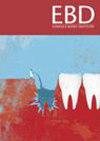Conventional methods and electronic apical locator in determining working length in different primary teeth: systematic review and meta-analysis of clinical studies
IF 2.3
Q3 Dentistry
引用次数: 0
Abstract
The aim of the current systematic review was to investigate differences in the measurement of working length in primary teeth between electronic apex locators (EAL) and radiographic methods (conventional radiography [CR] and digital radiography [DR]). A systematic search was conducted in six electronic databases (Medline via PubMed, Web of Science, Science Direct, Virtual Health Library, Scopus and Cochrane Database of Systematic Reviews). Gray literature and reference lists of included studies were also examined. The guiding question of the study was formulated using the PECO strategy (Population, Exposure, Comparator, Outcome): P: primary teeth submitted to pulpectomy; E: measurement of working length using the radiographic methods; C: measurement of working length using electronic apex locator; O: difference in working length. The methodological quality (QUADAS-2) and certainty of the evidence (GRADE) were assessed. Meta-analyses were performed, e foram considerados os tipos de radiografia, grupo de dentes, geração de localizadores apicais. I² statistics were calculated. Twenty-five studies were included in the review. Of these, eighteen studies were eligible for meta-analysis. Most studies demonstrated fair methodological quality. The working length measured using CR was, on average, 0.52 mm greater when compared to EAL (95% CI: 0.15–0.89, I2 = 75%). When comparing EAL and DR, no statistically significant difference was found (MD = 0.06 mm, 95% CI: –0.12 to 0.24; I2 = 0%). The majority of articles (n = 20) were considered to have fair quality and five had high quality. The findings of the present review demonstrate a difference in the measurement of working length using CR in comparison with EAL. No difference was found between the EAL and DR methods. The certainty of the evidence was considered low for all outcomes.

传统方法与电子根尖定位器测定不同乳牙工作长度:临床研究的系统回顾与荟萃分析。
目的:本系统综述的目的是研究电子牙尖定位仪(EAL)和x线摄影方法(传统x线摄影[CR]和数字x线摄影[DR])测量乳牙工作长度的差异。方法:系统检索6个电子数据库(Medline via PubMed、Web of Science、Science Direct、Virtual Health Library、Scopus和Cochrane Database of systematic Reviews)。灰色文献和纳入研究的参考文献列表也被检查。本研究的指导问题采用PECO策略(人口、暴露、比较者、结果)制定:P:接受牙髓切除术的乳牙;E:用射线照相法测量工作长度;C:使用电子顶点定位仪测量工作长度;O:工作长度差。评估方法学质量(QUADAS-2)和证据确定性(GRADE)。我们进行了meta分析,包括有孔的考虑者、放射学的考虑者、牙床的考虑者、牙床的考虑者、牙床的考虑者、牙床的考虑者和牙床的考虑者。计算I²统计量。结果:本综述纳入了25项研究。其中,18项研究符合荟萃分析的条件。大多数研究表明方法质量尚可。与EAL相比,CR测量的工作长度平均增加0.52 mm (95% CI: 0.15-0.89, I2 = 75%)。EAL与DR比较,差异无统计学意义(MD = 0.06 mm, 95% CI: -0.12 ~ 0.24;i2 = 0%)。大多数文章(n = 20)被认为具有一般质量,5篇文章具有高质量。结论:本综述的研究结果表明,与EAL相比,CR在测量工作长度方面存在差异。EAL法与DR法无差异。所有结果的证据的确定性都被认为很低。
本文章由计算机程序翻译,如有差异,请以英文原文为准。
求助全文
约1分钟内获得全文
求助全文
来源期刊

Evidence-based dentistry
Dentistry-Dentistry (all)
CiteScore
2.50
自引率
0.00%
发文量
77
期刊介绍:
Evidence-Based Dentistry delivers the best available evidence on the latest developments in oral health. We evaluate the evidence and provide guidance concerning the value of the author''s conclusions. We keep dentistry up to date with new approaches, exploring a wide range of the latest developments through an accessible expert commentary. Original papers and relevant publications are condensed into digestible summaries, drawing attention to the current methods and findings. We are a central resource for the most cutting edge and relevant issues concerning the evidence-based approach in dentistry today. Evidence-Based Dentistry is published by Springer Nature on behalf of the British Dental Association.
 求助内容:
求助内容: 应助结果提醒方式:
应助结果提醒方式:


